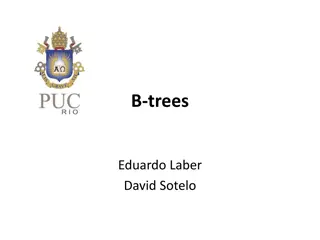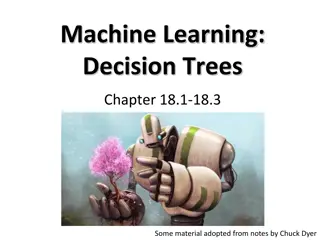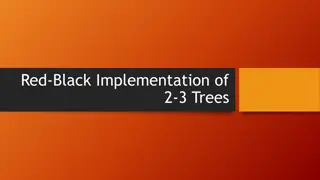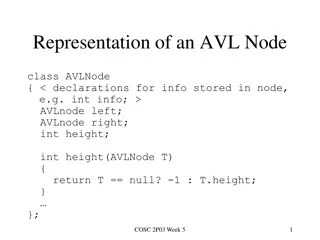Understanding Spanning Trees and Minimum Spanning Trees
Explore the concept of spanning trees and minimum spanning trees in graph theory through an in-depth lecture outline covering topics like Cut Property, Cycle Property, Kruskal's Algorithm, and more. Delve into the significance of Minimum Spanning Trees (MSTs) as the lowest-cost spanning tree of a graph and the possibility of multiple MSTs in a graph. Discover the application of Dijkstra's Algorithm in finding the shortest path in a graph and its relation to forming a spanning tree. Uncover proofs and insights into the formation of spanning trees from shortest paths.
Download Presentation

Please find below an Image/Link to download the presentation.
The content on the website is provided AS IS for your information and personal use only. It may not be sold, licensed, or shared on other websites without obtaining consent from the author. Download presentation by click this link. If you encounter any issues during the download, it is possible that the publisher has removed the file from their server.
E N D
Presentation Transcript
https://www.youtube.com/watch?v =dQw4w9WgXcQ CSE 421: Introduction to Algorithms Yin Tat Lee Guest Lecturer: Jeremy Lin (TA)
Lecture Outline: Spanning Trees / Minimum Spanning Trees Cut Property Cycle Property Kruskal s Algorithm Union Find Data Structure (Briefly) talk about Prim s and Reverse-Delete algorithms https://www.you tube.com/watch ?v=dQw4w9WgX cQ
Spanning Trees htt ps: //w ww .yo utu be. co m/ wat ch? v=d Qw 4w 9W gXc Q A tree T is a spanning tree of a graph G if: T is a valid tree (obviously) T includes all vertices in G T includes only edges in G (but possibly not all edges in G) More formally, if ? = ?,? and ? = (? ,? ) then: ? = ? ? = ? 1 ? ?
Minimum Spanning Trees (MST) An MST is the lowest-cost spanning tree of a graph 6 6 9 2 2 4 1 1 0 0 2 2 2 2 https://www.y outube.com/w atch?v=dQw4 w9WgXcQ 4
Minimum Spanning Trees (MST) https://www.youtube.com/watch?v=dQw4w9WgXcQ A graph may have multiple possible MSTs! Trivial example: 3 3 3 3 3 3 3 3 3 3 3 3 3 3 3 3 3 3 3 3 3
Yesterday: Dijkstras Algorithm Find the shortest path from vertex S to all other vertices in G Guaranteed non-negative edges, etc. If you draw out all the shortest paths calculated on G, do they always form a (spanning) tree? (Assume no two paths from S to T tied for shortest) https://www.yo utube.com/wat ch?v=dQw4w9 WgXcQ
http s:// ww w.yo utub e.co m/w atch ?v= dQw 4w9 WgX cQ Yesterday: Dijkstra s Algorithm Find the shortest path from vertex S to all other vertices in G Guaranteed non-negative edges, etc. If you draw out all the shortest paths calculated on G, do they always form a spanning tree? Yes! Proof Sketch: (Contradiction) Suppose that the graph G formed by connecting the shortest paths as described above is not a tree -> it must have a cycle by definition) Let T be a vertex in a cycle. Therefore, there must be two paths from S to T One of them is not used for any shortest paths, since for any of T s neighbors T we will always path from S to T by taking the shorter path from S to T first, then the path from T to T But then this contradicts how we constructed G !
Yesterday: Dijkstras Algorithm Find the shortest path from vertex S to all other vertices in G Guaranteed non-negative edges, etc. If you draw out all the shortest paths calculated: Do they form a (spanning) tree? Yes! Do they form a minimum spanning tree? https://ww w.youtube.c om/watch?v =dQw4w9W gXcQ
Yesterday: Dijkstras Algorithm Find the shortest path from vertex S to all other vertices in G Guaranteed non-negative edges, etc. If you draw out all the shortest paths calculated: Do they form a minimum spanning tree? No! Proof: (counterexample) 1 1 1 2 5 2 5 2 5 5 5 S S S 5 5 1 1 1 1 1 1 2 2
Why MSTs? LOTS of applications Network Design: Roads, TV cables, Electrical wires, etc. Approximations for (NP-) hard problems Travelling Salesperson And many more!
Properties of MSTs Cut Property Cycle Property
Cuts A cut is any partition of the vertices in G into two disjoint sets of vertices (denoted by (?,?)) The vertices in each set don t need to be connected to each other This will come up again later! ( Lecture 18 on flows and cuts) 1 1 2 2 5 2 5 2 5 5 5 5 1 1 1 1 2
Cut Property The lightest (least weight) edge connecting the two sets of vertices in each cut must be in every MST If there are multiple edges tied for the lowest weight then all MSTs must contain at least one of them 1 B A A B 1 2 2 5 2 5 2 C 5 C 5 G G E E 5 5 1 1 1 1 D D 2 2 F F
Cut Property General Proof: (contradiction) Say a cut (?,?) results in the two sets of vertices A and B. Say an MST includes an edge E going across the cut (connecting A and B). If there exists a lighteredge E going across the cut, then we would get a better MST by removing E and adding E instead. But this is a contradiction! A B 1 2 5 2 C 5 G E 5 1 1 D 2 F
Cut Property General Proof: (contradiction) Say a cut (?,?) results in the two sets of vertices A and B. Say an MST includes an edge E going across the cut (connecting A and B). If there exists a lighteredge E going across the cut, then we would get a better MST by removing E and adding E instead. But this is a contradiction! Minor details to think about: Prove that replacing E with E creates a valid tree (Hint: prove it doesn t create a cycle first) A B 1 2 5 2 C 5 G E 5 1 1 D 2 F
Cycle Property The heaviest (most weight) edge in every cycle in G cannot be in any MST If there are multiple edges tied for the highest weight then all MSTs can contain at most all but one of them A B 1 2 5 2 C 5 E 5 G 1 1 D 2 F
Cycle Property General Proof: (contradiction) Say that while constructing the MST we keep (all of the) heaviest edges in a cycle C and remove one of the lighter edges E instead But then we will be able to construct a better MST by removing one of the heaviest edges and adding E back in! But this is a contradiction! A B 1 2 5 2 C 5 G E 5 1 1 D 2 F
Cycle Property General Proof: (contradiction) Say that while constructing the MST we keep (all of the) heaviest edges in a cycle C and remove one of the lighter edges E instead But then we will be able to construct a better MST by removing one of the heaviest edges and adding E back in! But this is a contradiction! A B 1 2 5 2 Minor detail: Prove that replacing the heaviest edge forms a tree General sketch: Doing this doesn t create a cycle Keep number of edges the same -> by Pigeonhole Principle we form a valid tree still C 5 G E 5 1 1 D 2 F
Using Cuts and Cycles to build MSTs Kruskal s Algorithm Prim s Algorithm Reverse-Delete Algorithm (and more!)
Kruskals Algorithm: Greedy Algorithm! Greedy Rule: Add the lowest-cost edge that doesn t create a cycle Which property discussed previously does Kruskal s use? A B 1 2 5 2 C 5 G E 5 1 1 D 2 F
Kruskals Algorithm: Greedy Algorithm! Greedy Rule: Add the lowest-cost edge that doesn t create a cycle Which property discussed previously does Kruskal s use? Uses both Cut and Cycle Properties! A B 1 2 5 2 C 5 G E 5 1 1 D 2 F
Kruskals Execution: A B 1 A B 1 2 2 5 2 5 2 C 5 C 5 G G E E 5 5 1 1 1 1 D D 2 2 F F Minimum Spanning Tree Original Graph
Kruskals Execution: A B 1 A B 1 2 2 5 2 5 2 C 5 C 5 G G E E 5 5 1 1 1 1 D D 2 2 F F Minimum Spanning Tree Original Graph
Kruskals Execution: A B 1 A B 1 2 2 5 2 5 2 C 5 C 5 G G E E 5 5 1 1 1 1 D D 2 F 2 F Minimum Spanning Tree Original Graph
Kruskals Execution: Adds a cycle A B 1 A B 1 2 2 5 2 5 2 C 5 C 5 G G E E 5 5 1 1 1 1 D D 2 F 2 F Minimum Spanning Tree Original Graph
A B 1 Kruskal s Pseudocode: 2 5 2 C 5 G E Let ?? denote the weight of edge e. 5 1 1 D 2 F Kruskals(V, E): sort E in non-decreasing order (?0 ?1 ??) Initialize each vertex in its own island for i = 1 m: let ??= (?,?) if u and v are in different connected components: add ?? into the MST merge the connected components containing u,v return the MST
A B 1 Kruskal s Pseudocode: 2 5 2 C 5 G E Let ?? denote the weight of edge e. 5 1 1 D 2 F Kruskals(V, E): sort E in non-decreasing order (?0 ?1 ??) Initialize each vertex in its own island for i = 1 m: let ??= (?,?) if u and v are in different islands : add ?? into the MST merge the islands containing u and v return the MST How to do this efficiently? (easy O(n log n) implementation)
Union Find!!! Both a data structure and an algorithm Runtime: O(log n) for checking if two nodes are in the same group O(log n) for merging two groups
Union Find For each node, keep track of two things: Pointer to its parent Depth of its tree (length of longest path ending at that node) All pointers initially uninitialized, depth = 0 0 0 0 0 0 0 Depth Nodes 1 2 3 4 5 6
Union Find To check whether A and B are part of the same island : Follow the pointers up to the root of the tree, check if identical 0 0 0 0 0 0 Depth Nodes 1 2 3 4 5 6
Union Find To merge two islands : First find the root of each tree Assign the lower-depth root to point to the higher-depth root If roots are the same depth tiebreak arbitrarily Adjust the depths if necessary 0 0 0 0 0 0 Depth Nodes 1 2 3 4 5 6
Union Find Example Merge(2, 6) 0 1 0 0 0 Depth Nodes 1 2 3 4 5 0 6
Union Find Example Merge(4, 1) 1 0 0 1 Depth Nodes 2 3 4 5 0 0 6 1
Union Find Example CheckSame(1,2) CheckSame(6,2) 1 0 0 1 Depth Nodes 2 3 4 5 0 0 6 1
Union Find Example Merge(5, 4) 1 0 1 Depth Nodes 2 3 4 0 0 0 6 5 1
Union Find Example Merge(2, 4) 2 4 0 1 0 0 5 2 1 3 0 6
Union Find Example CheckSame(5, 1) CheckSame(6, 2) 2 4 0 1 0 0 5 2 1 3 0 6
Union Find Runtime Proof: Claim: If the label of a node is k, then there must be 2? elements in the tree Equivalently, if there are n nodes in a tree, the depth of the tree is at most log(n) General Proof: (Induction) Base case: True initially Inductive step: Each step we merge a tree of depth at most log(n) From inductive hypothesis it also must contain at most n elements Depth increases by at most 1, number of elements can double -> Inductive hypothesis holds! As a consequence, union find is guaranteed to be log(n) Or better! (See Tarjan s 1975 paper for details if you want)
A B 1 Kruskal s Runtime: 2 5 2 C 5 G E 5 1 1 Kruskals(V, E): sort E in non-decreasing order Initialize each vertex in its own island for i = 1 m: let ??= (?,?) if u and v are in different islands : add ?? into the MST merge the islands containing u and v return the MST Overall: O(M log M) = O(M log N) D O(M log M) O(N) O(M log N) 2 F O(log N) O(log N)
Kruskals Proof of Correctness: Add the lowest-cost edge that doesn t create a cycle -> Equivalently: If adding e to T creates a cycle, then delete it according to the cycle property Otherwise, add it according to the cut property
Other MST greedy algorithms: Prim s Algorithm: Similar to Dijkstra s Algorithm Start from an arbitrary vertex At each step add the lowest-weight edge coming out of the tree Straightforward application of cut property Reverse-Delete: Keep deleting the highest-weight edge unless it disconnects the graph (Somewhat) straightforward application of cycle property























